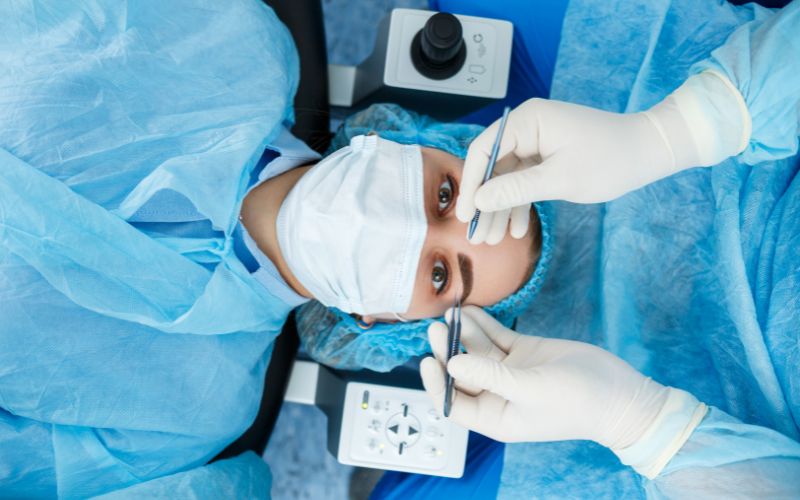Glaucoma is a prevalent problem in India and the third leading cause of blindness in India, especially among adults aged 40 and above. Even though there is no permanent cure, glaucoma can be successfully managed in 90% of cases, preventing vision loss and helping patients live a normal life. Learn about glaucoma surgery, including cost, side effects, complications, etc.
What Is Glaucoma?
Glaucoma is a group of disorders that damage the optic nerve and is a leading cause of irreversible blindness worldwide. While it can occur at any age, the disease is particularly prevalent among people aged 60 or older. A fluid buildup caused by a problem in the eye’s drainage system may increase eye pressure, thereby damaging the optic nerve. The problem starts at the edges and increases slowly, impacting central vision. While the problem develops in both eyes, it worsens in one eye.
There are different types of glaucoma, viz., open-angle glaucoma, closed-angle glaucoma, congenital glaucoma, etc.
How Is Glaucoma Diagnosed?
Glaucoma is difficult to diagnose as patients are unlikely to notice changes in vision until the condition is in its later stage. It is for this reason that doctors recommend regular eye checkups. The ophthalmologist may do a dilated eye exam to view the optic nerve or perform a gonioscopy to examine the angle where the iris and cornea meet. Other tests performed include OCT or Optical Coherence Tomography, Tonometry, Pachymetry, and Visual Acuity Test to check for changes in the optic nerve, measure eye pressure, measure corneal thickness, and check for vision loss, respectively.
The slit lamp examination helps examine the insides of the eye with a special microscope called a slit lamp.
How Is Glaucoma Treated?
While glaucoma cannot be reversed, it can be managed to prevent further damage through medication and surgery. While glaucoma eyedrops help manage eye pressure, they often cause a stinging sensation in the eyes. They could also potentially cause red eyes, changes in the pulse and heartbeat, eyelash growth, and dry mouth.

As for treatment options, glaucoma surgery and laser therapy. Glaucoma surgery types include:
Trabeculoplasty
Laser trabeculoplasty involves using laser beams to improve fluid drainage from the eye. Laser treatment is suggested as an alternative to eye drops or in addition to eye drops. While the effect of laser treatment lasts for several years, it does not replace the use of eye drops completely.
Iridotomy
This treatment is suggested to treat angle-closure glaucoma. During the process, the doctor creates a hole in the iris to allow the fluids to flow from the drainage angle. It is a painless procedure but may cause discomfort during the surgery.
Glaucoma Surgery
Trabeculectomy is performed, creating an opening in the sclera or the white part of the eye to allow the fluid to drain from the eye.
Minimally Invasive Glaucoma Surgery
MIGS helps lower eye pressure and is combined with cataract surgery. The procedure requires less postoperative care and is less risky when compared to conventional surgery.
Sometimes, the doctor may suggest using drainage tubes to drain the excess fluid and lower eye pressure. Irrespective of the glaucoma surgery type you choose, you will need a follow-up examination and even additional procedures if the eye pressure changes in the eyes.
Acute angle-closure glaucoma is a medical emergency, with patients needing immediate glaucoma surgery to reduce eye pressure.
Glaucoma Surgery Side Effects
As with any other procedure, glaucoma surgery comes with its own risks. Glaucoma surgery has very high success rates, but there could be a few side effects that you must discuss with your doctor. Some of the common glaucoma side effects include bleeding in the eye, infection, cataract formation, low eye pressure, and even vision loss.
While vision loss is not a common side effect, the surgery may temporarily disrupt your vision. As for infection, it could develop weeks, months, and even years after surgery. Contact the doctor immediately if you observe redness, pain, or excess tearing.
As for cataract formation, glaucoma surgery only accelerates it. Luckily, it can be fixed surgically and is sometimes combined with glaucoma surgery if the doctor feels that the cataract is impacting your vision.
While glaucoma surgery complications are manageable, you must inform the doctor immediately to report any problems.
How Much Time Does Glaucoma Surgery Take?
The procedure takes around 45 minutes to an hour, wherein the surgeon makes an incision and drains fluids from the eye.
Visit the best eye hospital in Nagercoil if you are looking for glaucoma surgery treatment. You’ll consult a professional eye specialist in Nagercoil to understand the procedure and its associated risks and benefits.
